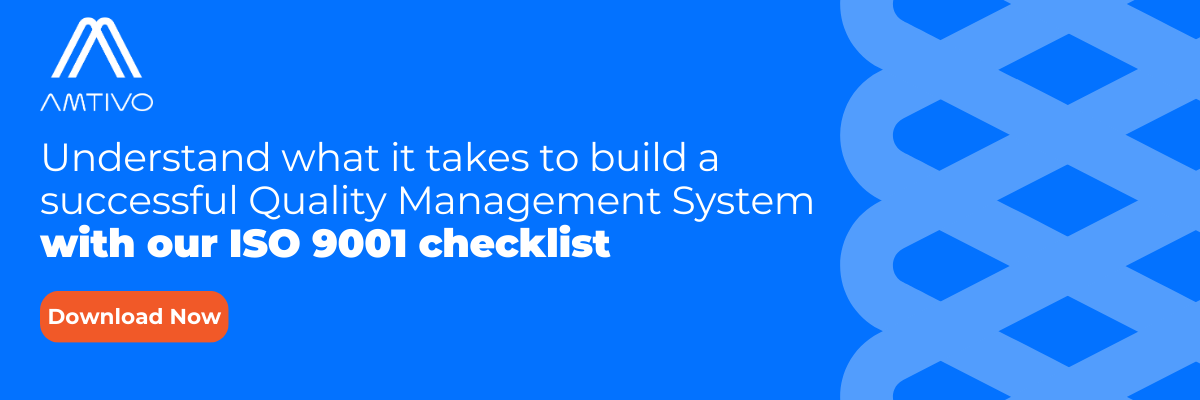Delivering high-quality products and services is essential for remaining competitive in today’s market.
There are two main approaches to quality management: Total Quality Management (TQM) and Quality Management Systems (QMS). But what’s the difference between them, and do you need them both?
TQM is a comprehensive approach focused on continual improvement and customer satisfaction. In contrast, a QMS provides a structured framework to meet quality objectives and comply with standards like ISO 9001.
In this article, we’ll compare TQM and QMS principles, exploring how they differ and how they can work together.
You’ll discover the key aspects of each approach and when and why a QMS might be necessary if TQM is already in place. By understanding the links between TQM and QMS, you’ll learn how organizations can optimize both approaches for enhanced quality management.
TQM vs QMS—A Quick Overview
What is TQM?
Total Quality Management (TQM) is a company-wide approach that focuses on fostering a culture of continual improvement and customer satisfaction. It emphasizes the importance of organizational commitment to quality across all levels.
TQM focuses on people and processes, encouraging active participation and collaboration for achieving quality objectives.
What Is QMS?
A Quality Management System (QMS) is a structured set of policies, processes, and procedures that helps organizations deliver consistent quality. It is often standardized and audit-driven, aligning with international standards such as ISO 9001.
This system provides a framework for maintaining consistency and compliance, serving as a core component of quality assurance efforts.
A key difference is that TQM is a philosophy or culture, whereas a QMS includes documented systems and procedures that can be independently audited.
A High-Level Comparison of TQM and QMS Principles
While TQM and QMS have similar principles, they also have their differences. This table lists the shared principles, including customer focus, leadership, and continual improvement, and highlights their complementary nature in promoting an effective quality management strategy.
|
Principle |
TQM |
QMS |
|---|---|---|
|
Customer Focus |
Central to all activities and improvements. |
This primary objective is embedded in processes and standards. |
|
Leadership |
Emphasizes leadership commitment to quality culture. |
Leadership drives the establishment of quality policies. |
|
Continual Improvement |
Ongoing focus on enhancing processes and systems. |
An integral part of the system, through mechanisms such as objective setting, performance monitoring, and corrective action. |
|
Process Approach |
Focus on improving processes through collaboration. |
Structured processes to achieve consistent outcomes. |
|
Involvement of People |
Encourages active participation from all employees. |
Involves employees to consistently follow established processes and contribute to ongoing quality efforts. |
Learn more about the 7 Principles of Quality Management.
Quality and Total Quality Management—Key Differences
While the principles of both TQM and QMS overlap—they both focus on customer satisfaction, continual improvement, and leadership—they differ in their application, structure, and scope.
Understanding these key differences can help your organization align its quality management strategies with its specific goals and requirements.
Scope and Structure
-
TQM: Total Quality Management is typically applied organization-wide to embed a culture of continual improvement, although its implementation may begin in specific functions.
-
QMS: A Quality Management System delivers a consistent, standardized approach that connects every part of your business under a shared commitment to quality. It uses standardized processes and procedures like those outlined in ISO 9001, connecting all parts of your business in the pursuit of quality.
Flexibility
-
TQM: TQM is highly flexible. It can be adapted to fit the needs of specific projects or departments. It encourages changes and enhancements that suit the unique needs of different parts of the organization.
-
QMS: QMS prioritizes consistency and uniformity across an organization. It focuses on meeting external standards by making every part of the organization adhere to established procedures and maintain quality consistency.
Certification and Audits
-
TQM: There is no formal certification process for TQM. It is more of an internal commitment to quality improvement, relying on the organization’s dedication to maintaining a quality-oriented culture.
-
QMS: QMS can be implemented independently, but many organizations choose to certify their system to ISO 9001 to demonstrate conformance to international quality standards. Certification requires regular independent audits to assess compliance. These audits verify that an organization adheres to international quality standards and is committed to quality assurance.
Formal Documentation
-
TQM: TQM places less emphasis on formal documentation and standardization than a QMS and more on cultural and procedural shifts.
-
QMS: A QMS requires detailed records of procedures, processes, and policies. Documentation is crucial for achieving and maintaining ISO certification. This documentation means that all quality processes are traceable and verifiable.

Do You Need a QMS if You’ve Implemented TQM?
Think TQM makes a QMS unnecessary? Not quite. While TQM drives valuable improvements, it doesn’t replace the structure and credibility a QMS delivers.
However, while TQM does offer valuable improvements in specific projects or departments, a QMS provides a standardized, organization-wide framework, offering organizations a scalable, auditable system to ensure consistent quality practices across all functions.
These are the main elements to consider:
Standardization
- TQM operates within a project-based or department-specific approach, allowing for tailored improvements. However, this can lead to variations in practices across different areas of the organization.
- A QMS supports a unified system to standardize processes and procedures throughout an organization. This consistency prevents conflicting practices and maintains uniformity in quality management, which is crucial for achieving high standards.
Auditing and Improvement
- TQM encourages continual improvement internally, focusing on enhancing processes based on internal insights and feedback.
- Building on this, a QMS includes independent audits that systematically identify gaps in processes and provide actionable Opportunities for Improvement (OFIs). These audits offer an objective assessment, helping businesses refine and optimize their quality processes.
Documentation and Recognition
- TQM may lack the formal documentary evidence required to achieve ISO 9001 certification, which can make it harder to prove your quality credentials—especially when pursuing new contracts or certifications.
- Achieving a QMS certification can give businesses a competitive edge in tenders by providing external validation of their quality processes. ISO 9001 requires documented evidence of compliance, which can be essential for securing new business and enhancing industry recognition.
- While TQM contributes significantly to quality improvements, a QMS provides the structure, consistency, and external validation needed to improve an organization’s quality management strategy and make it sustainable.

The Benefits of Implementing a QMS Alongside TQM
Integrating a Quality Management System to complement Total Quality Management efforts can significantly enhance an organization’s quality strategy. It can provide a more structured, audited approach to quality management, helping businesses stay competitive and meet industry standards.
Easier to Get Other Certifications
Implementing a QMS certified to ISO 9001 can make achieving additional ISO standards easier, including ISO 14001 for environmental management and ISO 27001 for information security. Thanks to the Annex SL framework—a shared structure used across ISO standards—adding new certifications is easier when you already have a QMS in place.
Organizations can streamline their certification efforts and make it less complex to achieve multiple standards.
Improved Business Opportunities
ISO 9001 certification lends credibility to TQM efforts, making it easier for businesses to win new clients and enter new markets. Certification provides third-party verification that your organization takes quality seriously. showing customers and stakeholders you take quality seriously.
In some industries, ISO certification is often a prerequisite for contracts. A certified QMS boosts an organization’s credibility, opening doors to lucrative opportunities that might otherwise be inaccessible.
Better Operational Efficiency
Another significant benefit of implementing a QMS alongside TQM is improving operational efficiency. A QMS offers a clear framework for documenting processes and procedures, which helps to identify areas for improvement.
This organized approach improves process consistency and continual improvement initiatives—which means less waste, lower costs, and increased productivity.
Read more about the benefits of a Quality Management System.
Using TQM and QMS Together: A Winning Strategy
Combining a QMS with TQM boosts the benefits of both approaches, offering a robust strategy for achieving quality excellence and driving business success.
While Total Quality Management emphasizes building a culture of continual improvement at a project or departmental level, a Quality Management System provides an organization-wide framework that drives standardization, certification, and regular audits. Together, these approaches complement each other, offering a comprehensive strategy for achieving and maintaining quality excellence.
For organizations wanting to improve their quality management strategies, looking into establishing a QMS and understanding the benefits of ISO 9001 certification can be a smart move.
By adopting both TQM and a QMS, businesses can boost their efficiency, strengthen their reputation, and set themselves up for long-term success in a competitive market.
Learn more with our guide to Quality Management Systems and our helpful resources, including our:
- ISO 9001 Implementation Course
- 10-step ISO 9001 Compliance Checklist
- ISO 9001—Meaning, Requirements and Beginner’s Guide
Ready to take the next step toward certification success? Get a personalized quote or speak to one of our experts today.






